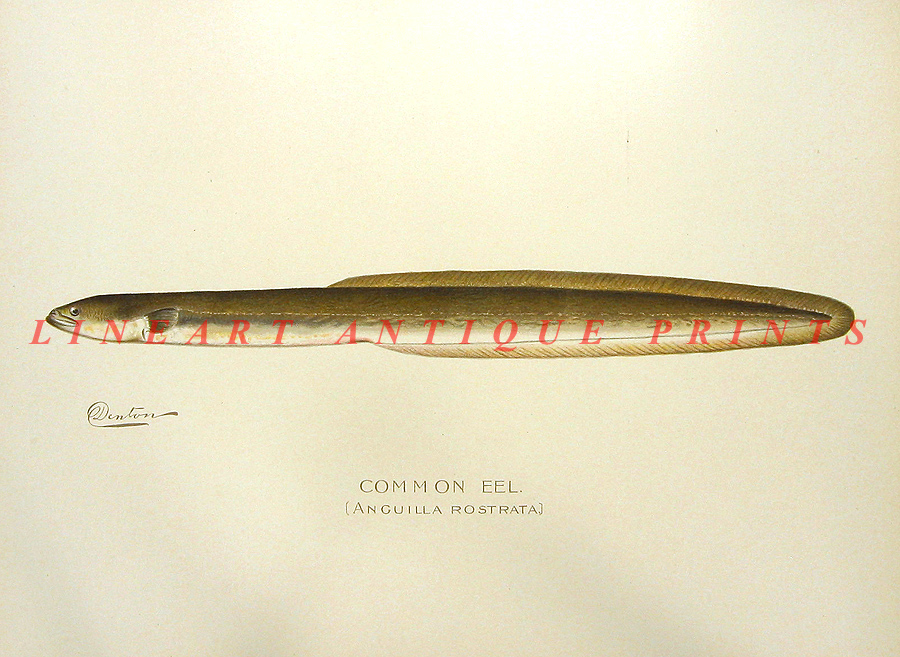|
|
COMMON EEL.
(Anguilla Rostrata)
Artist: Sherman Denton |

NOTE: THE RED LETTERING ON THE PRINT IS A WATERMARK I ADDED DIGITALLY AND IS NOT ON THE ACTUAL PRINT!
CLICK HERE TO SEE MORE 19th CENTURY FISH & GAME COLOR PRINTS!!
PRINT DATE: This lithograph was printed in 1902; it is not a modern reproduction in any way.
PRINT SIZE: Overall print size is 8 x 11 inches.
PRINT CONDITION: Condition is as shown in this detailed picture of the print. Print is on thick cardboard like paper and is blank on reverse.
SHIPPING: Buyer to pay shipping, domestic orders receive priority mail, international orders receive regular air mail unless otherwise asked for. We take a variety of payment options. Full payment details will be in our email after auction close.
We pack properly to protect your item!
PRINT DESCRIPTION :
The American eel, Anguilla rostrata, is a catadromous fish found on the eastern coast of North America. It has a snake-like body with a small sharp pointed head. It is brown on top and a tan-yellow color on the bottom. It has sharp pointed teeth but no pelvic fins. It is very similar to the European eel, but the two species differ in number of chromosomes and vertebrae. Juvenile eels.The eel lives in fresh water and only leaves this habitat to enter the Atlantic ocean for spawning. It takes 9 to 10 weeks for the eggs to hatch. After hatching, young eels move toward North America and enter freshwater systems to mature. The female can lay up to 4 million buoyant eggs a year, but dies after egg-laying. The eel is found around the Atlantic coast including Chesapeake Bay and the Hudson River. It prefers to hunt at night, and during the day it hides in mud, sand or gravel very close to shore, roughly 5 to 6 feet under. American eels are economically very important to the East Coast and rivers where they travel. They are caught by fishermen and sold, eaten, or kept as pets. Eels help the Atlantic coast ecosystem by eating dead fish, invertebrates, carrion, insects, and if hungry enough, they will cannibalize each other. Although many anglers are put off by the snake-like appearance of these catadromous fish, eels are in fact exceptionally good fish. They are usually caught by anglers fishing for something else. The world record weight for the American eel is 9.25 pounds. The life stages of the American eel are leptocephali, glass eel, yellow eel, and silver eel. Leptocephali metamorphose into glass eel as they migrate toward land and bodies of freshwater. Glass eel develop pigmentation as they move into brackish water or freshwater. Usually by two years of age, small, pigmented eel make the transition into yellow eel. Yellow eel inhabit fresh, brackish, and saltwater habitats where they feed mostly on invertebrates and smaller fishes. Sexual maturity occurs around 4.5 years of age. When yellow eel become sexually mature, they begin a downstream migration toward the Sargasso Sea's spawning grounds. During this migration, yellow eel metamorphose into their adult silver eel phase, undergoing several physical changes. Adult silver eel are believed to spawn in the Sargasso Sea during winter and early spring.
Sherman Foote Denton (1856-1937) was born in Wellesley, Massachusetts , S.F. Denton was a multi-talented artist, scientist and skilled entrepreneur in business. His interest in natural history encompassed not only fish, but butterflies and moths, insects, birds, fossils, freshwater pearls and gems. During the 1880s, he and his brothers went on trips to the Western U.S. and accompanied their father, a geologist, on an expedition to Australia, New Zealand and New Guinea, where collected natural history specimens. Returning to the U.S., Denton worked as an artist for the United States Fish Commission at the Smithsonian Institute between 1896 and 1890, where he illustrated their reports with chromolithograph prints and also developed and patented a method for mounting fish without losing the natural colors. He became the leading maker of fish models for collectors and museums such as the Smithsonian, the Field Museum in Chicago and the Agassiz Museum at Harvard. He also invented a method for mounting butterflies, and amassed the most important collection of freshwater pearls in the U.S. Sherman, along with his brothers William, Winsford and Shelley (a noted naturalist in his time) became famous at the 1900 Paris Exposition for their award-winning moth and butterfly collections. Sherman Denton was also renowned among the leading naturalists of his day for developing and patenting methods to preserve fish, butterflies and moths in a much more life-like state.
GREAT GIFT FOR A BIG GAME OR BIRD HUNTER, OUTDOORSMAN, FISHERMAN, ANGLER OR NATURALIST ! HANG IN YOUR DEN, OFFICE, CABIN OR BASEMENT.
|
|
|

